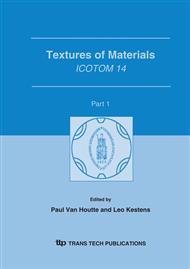p.203
p.207
p.213
p.219
p.225
p.231
p.237
p.245
p.255
Extension of Orientation Mapping to the Transmission Electron Microscope
Abstract:
This paper describes progress in improving the spatial resolution of the well-established Orientation Imaging Microscopy technique, OIM, by developing an analogous procedure for the transmission electron microscope. The transmission orientation micrographs are obtained by recording a large series of dark field micrographs taken from the chosen area in the specimen. This area is selected so that it contains all of the grains of interest and is imaged at sufficiently high magnification to yield the spatial resolution required. The changing intensity of each pixel in different dark field micrographs permits the equivalent of a diffraction pattern for that pixel to be constructed. This enables determination of the lattice orientation of small volumes in the sample corresponding to that imaged in each individual pixel. Experimentation has shown that problems arise however, that decrease the fraction of correctly measured points due to ambiguities in determining the index of higher order reflections, especially when the total number of reflections observed is small. The solution has been to both modify the indexing procedure and to sum the diffraction vectors observed within a single grain. The paper concentrates on a detailed analysis of a heavily deformed aluminium sample, chosen because of the fragmentation of the structure.
Info:
Periodical:
Pages:
225-230
Citation:
Online since:
September 2005
Authors:
Keywords:
Price:
Сopyright:
© 2005 Trans Tech Publications Ltd. All Rights Reserved
Share:
Citation:


